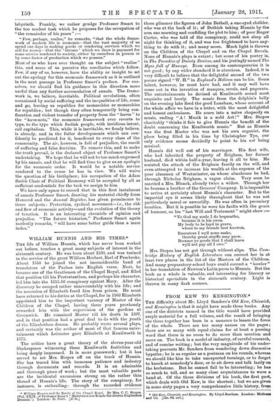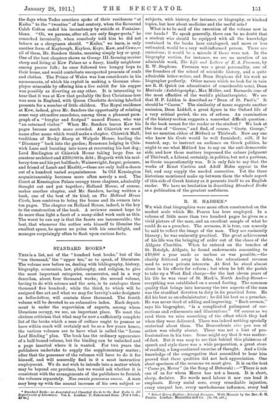FROM KEW TO KENSINGTON.*
THE difficulty about Mr. Lloyd Sanders's Old Kew, Chiswick, and Kensington is that it might have made three books. Any one of the districts named in the title would have provided ample material for a full volume, and the result of bringing the three together has been in a measure to lessen the force of the whole. There are too many names on the pages ; there are so many with equal claims for at least a passing word that there is no room to do more than mention and move on. The book is a model of industry, of careful research, and of concise writing; but the very magnitude of his under- taking prevents Mr. Sanders from wandering down discursive bypaths ; he is as regular as a postman on his rounds, whereas we should like him to take unexpected turnings, or to forget to knock at somebody's door, or to sit down and talk lazily on the kerbstone. But he cannot fail to be interesting; he has so much to tell, and so many close acquaintances to wave a hand at. Of the three divisions of his book, the first pant, which deals with Old Kew, is the shortest ; but we are given in some sixty pages a very comprehensive little history, from • Old Kew, Chiswick, and Kensington. By Lloyd Sandals. London : Illetham and Co. [12e. 6d. net.] the days when Tudor courtiers spoke of their residences "at Kaiho " to the "twenties" of last century, when the Reverend Caleb Colton ended his incumbency by suicide at Fontaine- bleau. "Oh, we parsons, after all, are only finger-posts," he remarked laconically, when somebody told him he did not behave as a clergyman should. " K.aih.o," we learn, is only another form of Kayhon,gh, Kayhoo, Keyo, Ka.w, and Cewe,— all of them, Mr. Sanders thinks, meaning simply key or quay. One of the best chapters shows us George ILL farming merino sheep and living at Kew Palace as a fussy, kindly neighbour among poorer folk ; he once followed two hungry boys to their home, and would contribute unexpected presents of coals and clothes. The Prime of Wales was less considerate in his amusements, of which his exploit in making a German oboe- player miserable by offering him a live rabbit for his supper was possibly as diverting as any other. It is interesting to hear that it was at Kew that probably file firstChristmas-tree was seen in England, with Queen Charlotte devising labelled presents for a number of little children. The Royal residence at Kew, indeed, gives Mr. Sanders the opportunity of relating some very attractive anecdotes, among them a pleasant para- graph of a "burglar and footpad" named Frame, who was "an esteemed visitor." When Mr. Sanders leaves Kew his pages become much more crowded. At Chiswick we meet name after name which would make a chapter. Chiswick Mall; traditions of Becky Sharp at Walpole House, hurling the " Dixonary" back into the garden; Rousseau lodging in Chis- wick Lane and bursting into tears at recovering his lost dog ; Lord Burlington at Chiswick House faking large fees as amateur architect and 400,00 in debt ; Hogarth with his mul- berry-tree and his pet bullfinch; Waineweight, forger, poisoner, and friend of Lamb and Hazlitt,—thee are only half-a-dozen out of a hundred varied acquaintances. In Old Kensington acquaintanceship becomes more often merely a nod. The Court at Kensington Palace occupy three chapters, admirably thought out and put together; Holland House, of course, makes another chapter, and Mr. Sanders, having written a book, one of the best of its kind, on The Holland House Circle, here contrives to bring the house and its owners into ten pages. The chapter on Holland House, indeed, is the key' to the construction of the book. A reviewer cannot hope to do more than light a facet of a many-sided work such as this. The worst he can say is that the facets are innumerable; the best, that whenever the author sets himself to illumine the smallest space, he spares no pains with his searchlight, and manages surprisingly often to flash upon curious facts.























































 Previous page
Previous page